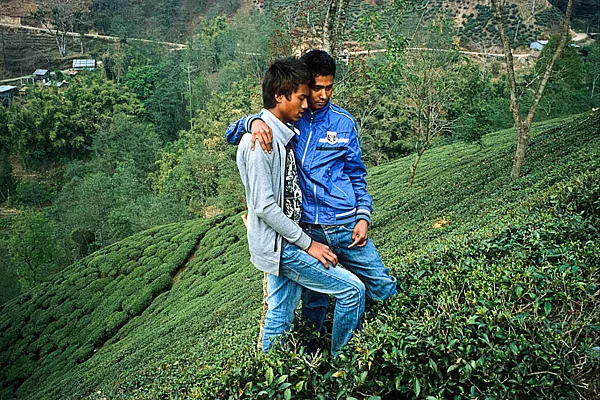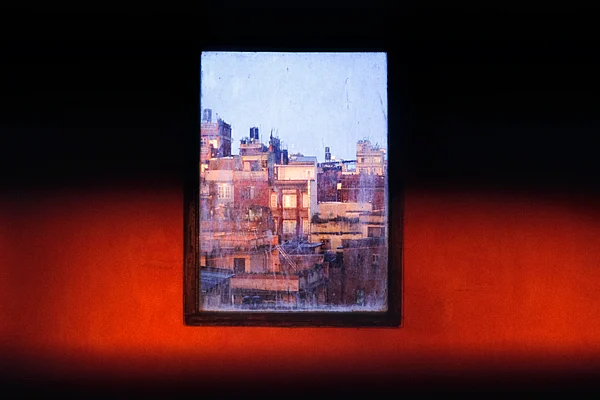
Frédéric Lecloux, a Belgian-French photographer, was drawn to Nepal in his 20s by the travel guides and books that spoke of the magic of the Himalaya, the cultures to be discovered, and the many lives to be lived on the roads between the peaks. With Cat Steven's Katmandu as his soundtrack, he photographed the mountains in all their glory, creating postcards that confirmed what he had seen in his dreams. As is the case with many travellers, in his first journeys in the 1990s, he was living more in the words and images he had seen of Nepal than with the world in front of him.
Lecloux found himself returning again and again to Nepal, during the civil war that killed many thousands, during reconstruction, during the failure of the successive governments to give the people what it had promised, during the famines, and most recently, during the earthquakes in April-May 2015. At first, he donned the image of the photojournalist working for NGOs and newspapers. But soon, he knew this was not his purpose. He was not there to document for posterity the historical landmarks that Nepal would be known by.
Lecloux was and is in Nepal because it is where he knows he wants to be, and perhaps because it is where he needs to be. It is this space of knowing, of letting go of the need to explain 'why Nepal', that has created 'Everyday Epiphanies'. Photography, more than any other medium, has always carried a moral charge and found itself endlessly burdened with the question of "why". In recent times, this weight and stream of endless justifications have produced not just banal visual stories, but a culture where the words explaining a body of work take precedence over the work itself.
Lecloux rejects this.
And the choice of images, and the paucity of words explaining them, makes this rejection abundantly clear. All he gives us in answer to the question of why he is in Nepal making these images of youth and silence is a quote by Henri Michaux: "As if there still weren't enough of reality, of that awful reality…"

Even though the world we enter through his photographs is that of a country we know, what we are being given is not its physical reality, but the many realisations that are possible in the rare space of anonymity and intimate otherness that Nepal provides.
Walking the streets of Patan, where Photo Kathmandu, the first international photo festival in Nepal, has been anchored, one feels not unnoticed but unobtrusive, a welcome sense of unbelonging without the fear of being undesired. Stumbling into a hidden courtyard beyond its templed streets, the world is silenced and one can tremble in the cold, watching the pigeons flutter on the windows. Sitting on those aged stones, a single photograph from the series comes to my mind: a girl in a white sweater sits on the edge of a long desk before a blackboard, it seems as if the board rests on her shoulders. We are sitting behind her and the light coming through the window gently turns the empty room a lilac-grey. The red of the brick walls is echoed in the strands of her hair, turning red in the cooling light. It is that photograph that becomes my travel guide to Nepal, a new guide that tells me to look beyond and within.
An epiphany is effortless in the moment of its occurrence, like a photograph, but can only emerge after a considerable journey. So while these are photographs of the most quiet and quotidian scenes on the streets and homes in Nepal, they are epiphanic for Lecloux in that he has arrived at the ability to see them after an immersion of many years.
This is the first time his work has been displayed in such a publicly accessible space (as is the case for many artists showing at Photo Kathmandu) and every day people have gathered and gazed, slowing down their motorbikes and lifting up their children to get closer to his vision. Every evening, Lecloux lights oil lamps at the foot of the photographs. This moment of 'seeing' comes to life among the very people who he has lived with for so many years. It is special, maybe even spiritual. To mark it along with the coming of Diwali is a beautiful gesture.
One night I stopped to take in the sight and saw Lecloux standing round a group of young Nepalis. He introduced me and said, "I have known them all since they were children! This is Reema, this is Parbat and this is Ram." We shook hands and they said how happy they were to see Lecloux's work. The next day I learned that these smartly dressed men and women were children who had been rescued off the streets of Kathmandu. Lecloux had met them with his wife through a small NGO and stayed in touch over the past decade. I couldn't help but wonder what they saw in his photographs – their Nepal? His Nepal? Whose Nepal?
~ Frédéric Lecloux's exhibition 'Everyday Epiphanies' is currently being shown as part of Photo Kathmandu in Patan (Dhaugal – South Wall), Nepal. Lecloux will be speaking about his journey of 22 years in Nepal on the 10 November 2015 at 4:30pm at the Bikalpa Art Center, Harihar Bhawan. The Patan community has requested that the photographs be left up on the wall, so the end date of the exhibition is currently unknown.
~ Alisha Sett is a writer based in Bombay. She graduated from Tufts University in 2012 with a BA in Political Science and English.

